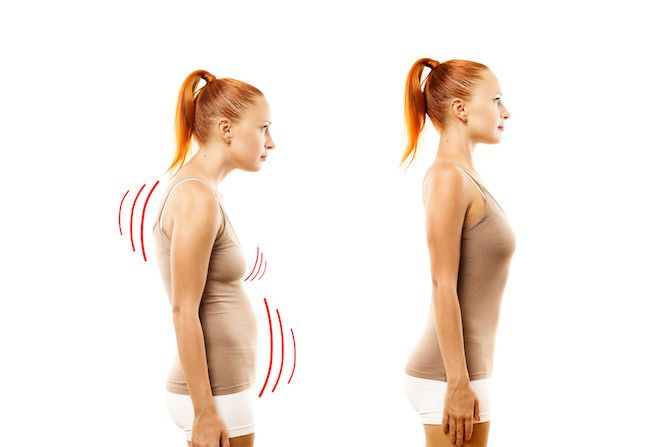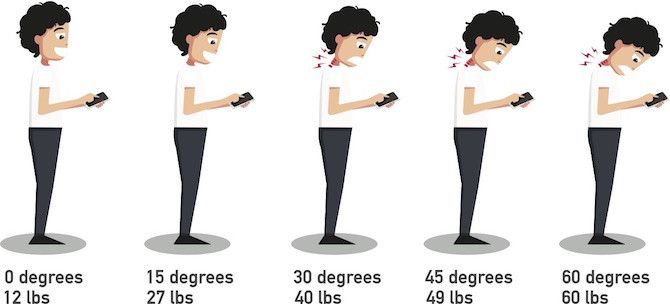Many of us use our phones, tablets, and computers day in and day out. Unfortunately, the postures we hold when we're using these devices are contributing to serious problems for our spines.
While it's unrealistic to suggest we stop using our electronics entirely, there are some easy changes out there. By taking a load off your neck, shoulders, and back, you'll see immediate improvements in your posture and health. Not only that, but you will also be saving yourself from tons of musculoskeletal problems down the road.
Why does posture matter? Which gadgets are causing real problems? And, most importantly, how do you fix the problem?
Keep reading to find out!
Benefits of Good Posture
Basically, the better your body's alignment is, the better your body will work! Sitting or standing in correct posture allows your muscles to move at the exact angles and forces they are supposed to.
Sadly, the reverse is also true. The moment you throw any positioning off, your body has to compensate with other muscles or joint positions. This compensation is when you will start to notice tight muscles, sore joints, pain, and reduced function.
The benefits of good posture go far beyond your physical health (although that should be motivation enough). Good posture can also help you to look taller and thinner: your head goes up, your belly goes in, and your shoulders go back.
Not only that, but many people find that good posture can also help you to both feel more confident and seem more confident to those around you!
Is My Posture Really That Bad?
Chances are, even if you're someone who always stands up straight, your posture is still modified when you use electronics. If you think about it, most of our gadget use occurs with our arms coming towards the middle of our bodies, and involves us looking down.
These movements cause internal rotation of the shoulder joint and put a lot of strain on the neck and shoulders. Both postures, even if only used temporarily, can have serious implications for your spine over time.
If you want to improve your standing posture, follow the image above from head-to-toe:
- Eyes should be looking straight ahead.
- Ears should be in line with your shoulders.
- Chin should be tucked in.
- Shoulders should be pulled back.
- Spine should be straight.
- Hips should be under your shoulders.
- Weight should be evenly distributed on both legs.
For more posture suggestions and corrections, the NHS website has a great guide with additional images.
Which Gadgets Are Affecting Your Posture?
1. Texting on Your Phone
When you look down to send a text or scroll through social media, you pull your head forward and out of alignment. This is an issue because heads are heavy -- the average adult head weighs about 10 pounds! A 2014 study by Hansraj found that "Text Neck" causes up to 50 pounds of forces acting on your neck.
Frankly, the muscles and vertebrae in our necks weren't designed to withstand that kind of pressure. If left uncorrected, this posture can lead to pain, stiffness, permanent changes in your muscles, and maybe even surgery.
The Solution
To avoid text neck completely, try holding your phone up at the level of your eyes. This will maintain proper spinal alignment, and keep you from looking down at the screen.
If you're at home, you can also achieve this by lying on the ground while holding the cell phone up in the air. Just be careful you don't drop it on your face. We've all been there.
2. Talking on Your Phone
Talking with your phone cradled between your ear and your shoulder may make you feel like a high-powered businessperson, but it's doing some serious damage.
Maintaining that posture for any length of time causes one side of your neck muscles to shorten, while the other side is stretched out. This posture also results in you hiking your shoulder up towards your ear. These movements can cause serious neck and shoulder pain if left unchecked.
The Solution
Thankfully this is one of the easiest postural problems to fix. Instead of cradling the phone with your ear and shoulder, use headphones with a microphone, a headset, or speakerphone. In a worst-case scenario, at least ensure you are regularly switching which side you are using to hold your phone.
3. Curling Up With a Tablet
The portability of tablets is great, but can also lead to some less-than-ideal postures. One of the most common postures for tablet users is to curl up on a couch, looking down at their tablet, with their knees bent.
Unfortunately, this causes a whole host of problems. Looking down causes similar forces with a tablet as it does with a smartphone. In addition, curling up affects your whole spine, and generally prevents your back from being supported by the couch or chair that you are sitting in. Last, bending your knees without support underneath them can cause wear and tear.
The Solution
While curling up on the couch may feel comfortable, it definitely isn't good for you long-term. Experts agree that the best way to use a tablet is to place it on a table in a stand that props it up. You can then sit at the table with your shoulders back and access it without negatively affecting your spine.
If you want to stay on the couch, try supporting your body with a pillow at your lower back and/or behind your neck. Then, rest the tablet on a pillow supported by your knees and use it with your shoulders back and your head upright. This additional support can make a world of difference in preventing pain or discomfort.
4. Sitting at Your Computer
Most people have heard lectures about the importance of sitting properly at your computer desk.
https://www.anrdoezrs.net/links/7251228/type/dlg/sid/UUmuoUeUpU46770/https://vimeo.com/71441709
Improper positioning at your desk (where you may spend upwards of six hours a day) can lead to significant musculoskeletal problems. The effects include tight hamstrings, pain in your lower back, or tension in your shoulders. These problems can in turn lead to compensatory pain in other parts of your body, affect your regular posture, or cause tension headaches.
The Solution
For long-term computer work, having a workstation set up properly for your body is key. Joel covers several tips in his article about proper workstation setup (below). Ergonomics.com also has an in-depth ergonomics guide for work or home.
If you're just working temporarily, and don't have an ideal workstation, there are still some things you can do to protect yourself. Try sitting in a good chair or against a wall (with pillows added as needed). Then, place your laptop on your lap (it's best if you place it on a laptop tray if you own one) and keep your arms and shoulders relaxed.
Another great solution is to switch to a standing desk. While this might not be possible for everyone, if you have a chance to use one you could see some serious benefits!
5. Carrying Gadgets
A final influence that our gadgets have on our posture comes from the work we do carrying them around! For example, my 15-inch MacBook Pro weighs 5 pounds -- and I can feel every ounce of it after my walk home from class!
Every pound we carry (whether in our arms, a purse, a messenger bag, or a backpack) places stress on our body. This is especially true for cross-body bags like messenger bags and purses, which place uneven forces on the spine.
A study at the University of Michigan found that those using messenger bags caused the spine to move laterally away from the weight of the bag, while the neck moved towards the weight of the bag. Over time, the uneven distribution of this weight can have awful effects on your spine health.
The Solution
Messenger bags may look cool, but they definitely aren't a good choice if you want to maintain good posture.
The same study found that backpacks had much less influence on spinal alignment and muscular stress. When choosing your backpack, be sure to select one that fits you properly and ensures an even distribution of weight. The National Posture Institute features a great guide to fitting your backpack properly.
Promoting Good Posture
Even with the best positioning, our use of electronic devices encourages some bad habits. To counteract the influence of these positions, it's a good idea to work some posture-enhancing stretches into your day.
Chin Tuck -- This stretch helps to bring your chin back into proper alignment, which is a huge issue for many of us. To do this stretch, simply pull your chin backwards like you're making a double chin. Be sure you're moving your chin back, and not just pointing your head down.
Scapular Retraction -- This stretch will bring your shoulders back and help to strengthen the muscles that keep them that way. Imagine you are trying to pull your two shoulder blades together. Your shoulders should come up and back, and you should feel muscles tightening in the middle of your back.
Neck Mobility -- Your neck has to deal with a lot of stress! However, because it is such a delicate part of your body, I'm hesitant to recommend any specific stretches. Search YouTube for a few neck-focused stretching routines, or speak with your doctor or physiotherapist to find a stretching solution that will work best for your needs!
Pectoralis Minor -- This is a final simple stretch that can make a world of difference if you have rounded shoulders. Rounded shoulders often come from shortened/tense pectoralis minor muscles and this stretch helps them to release, allowing you to maintain an upright posture more easily.
Do you struggle with your posture? If you have any questions or suggestions for improving posture with gadget use, let us know in the comments!
Image Credits: CREATISTA/Shutterstock



